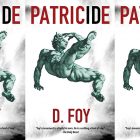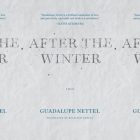Curb’s Exploration of American Othering

Curb
Divya Victor
Nightboat Books | April 20, 2021
Divya Victor’s poetry collection, Curb, begins as a meditation of the immigrant self—in this instance, a South Asian American self—in post 9/11 United States. She prefaces her book with four names in four locations: Balbir Singh Sodhi (Mesa, Arizona), Navroze Mody (Jersey City, New Jersey), Srinivas Kuchibhotla (Olathe, Kansas), Sunando Sen (Queens, New York). The names indicate these people’s South Asian lineages and not much more. In these initial pages, Victor provides no clues about who they are except that their deaths were as a result of “the force of feeling and action” for which the United States is responsible. It is only later, in poems dedicated to each of the named that Victor provides context to the racist violence that these four American men experienced. These names and the violence connected to them form the basis of the collection.
Curb began, in Victor’s own words, as an “artist’s book,” before it evolved into the poetry collection out next week. As Victor explains:
The work focuses on historical scenes that have set the stage for critical and communal discourse on hate crimes committed against South Asian migrants within a larger context of anti-Muslim and anti-immigrant sentiment in the United States, which have seen a documented rise since the attacks on the World Trade Center, spiking after the 2016 Presidential elections.
The artist’s book, published in 2017, was designed and printed by Victor’s collaborator from her undergraduate days, Aaron Cohick. It shaped like an accordion and opened both horizontally and vertically, much like those tourist maps prevalent in the pre-Internet days, hinting at the ways in which tourists and new immigrants in America navigated spaces as outsiders.
This theme of a racialized South Asian immigrant as outsider persists in the collection’s current form. In poems like “Settlement,” “Hedges,” both “Lawn” poems, and others, Victor marks the pages with latitude and longitude coordinates. In her “Notes and Objects Cited” placed at the end of the book, she notes that “A reader might find the location of any of the marked poems in Curb using the facility at www.-gps-coordinates.net.” These coordinates not only identify the reader, especially the racialized reader, as outsiders, but also locates the poems in very specific spaces. In this way, the poems become memorials of sorts, leading the reader into an experience of another project altogether.
The reader, in engaging with the coordinates, becomes more than just a passive consumer of these poems; they take an active part in learning more about what the poems are trying to accomplish. For example, looking up the coordinates of the first poem, “Settlement,” we see that Victor has led us to Ellis Island, America’s first immigration inspection center. Victor states in her citation that the poem is a reference to Srinivas Kuchibhotla, “who was an Indian aviation systems engineer at the GPS manufacturer, Garmin, when he was murdered by [a] white supremacist.” By juxtaposing Kuchibhotla’s murder and America’s first immigration center, Victor points to the hegemony of immigrant bodies, where white immigrant bodies are considered more American, while others like racialized Kuchibhotla remain othered even in death.
Victor also highlights the arbitrariness in the bureaucracy that dictates the process of becoming an immigrant in “Petitions (For An Alien Relative).” In “Second Petition,” for example, Victor juxtaposes the language of a legal U.S. immigration form with that of an internal dialogue: “Write here, if you know this place as home, about a beloved / whose skin you cannot live without.” The juxtaposition reveals that even as a U.S. citizen, and as someone who is part of the American imaginary, if racialized, one needs to justify the inclusion of someone they love within that American imaginary.
This justification itself relies on boxed choices such as “Spouse . . . Parent . . . Brother/Sister . . . Child,” as explored in “Third Petition.” These rigid, boxed choices do not allow for the existence of anyone who falls outside of the relationships defined by the U.S. bureaucracy. These boxes also point to the inherent racism underlying immigration policies where the State decides which bodies can become a part of the American imaginary and which bodies will perpetually remain outside.
At the same time, it becomes clear in “Last Petition,” that becoming an immigrant in America doesn’t automatically allow for becoming a part of the American imaginary: “yes, I remember, we / parceled our family / into placeholders /. . . & huddled in the warmth of an archive / set on fire.” The accepted (by the State)—the immigrant—has to discard the excess of their identity in order to be desirable as an immigrant. Any supporting documents that are not required are the excess here. It is this excess of an “archive” that is then “set on fire,” so that the immigrant can be assimilated within the American imaginary. In the end, the only way to become “American” is to discard who you were before that becoming, othering yourself in the process.
Curb highlights an ongoing injustice in this country: that the only thing that connects an immigrant to the American land after their death (or murder) will be a “written/ . . . scrap tied to a place / which holds your feet / to the ground.” Victor’s collection is thus a must-read, in its offering of a moving critique of the South Asian immigrant experience within post 9/11 America.



